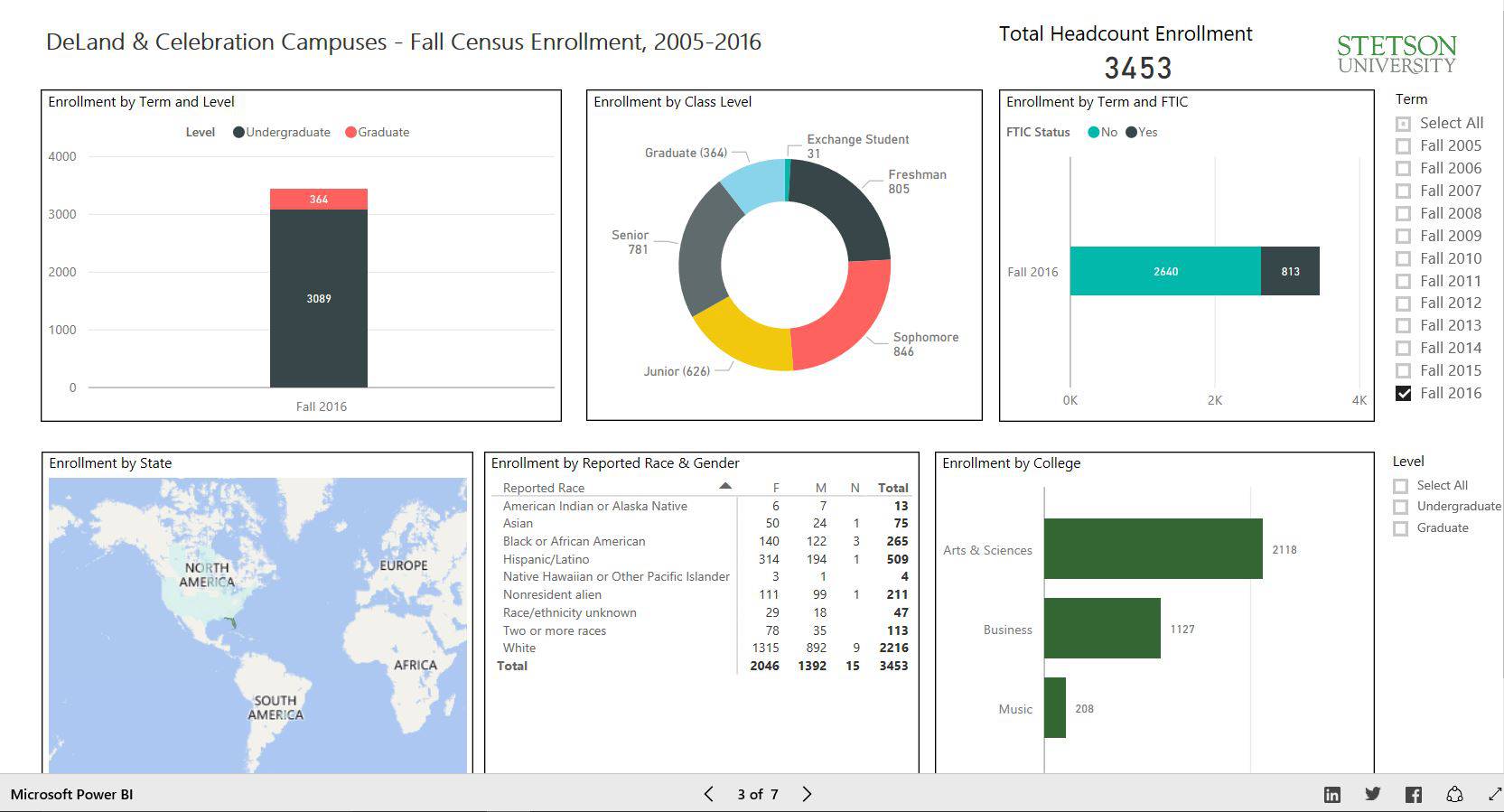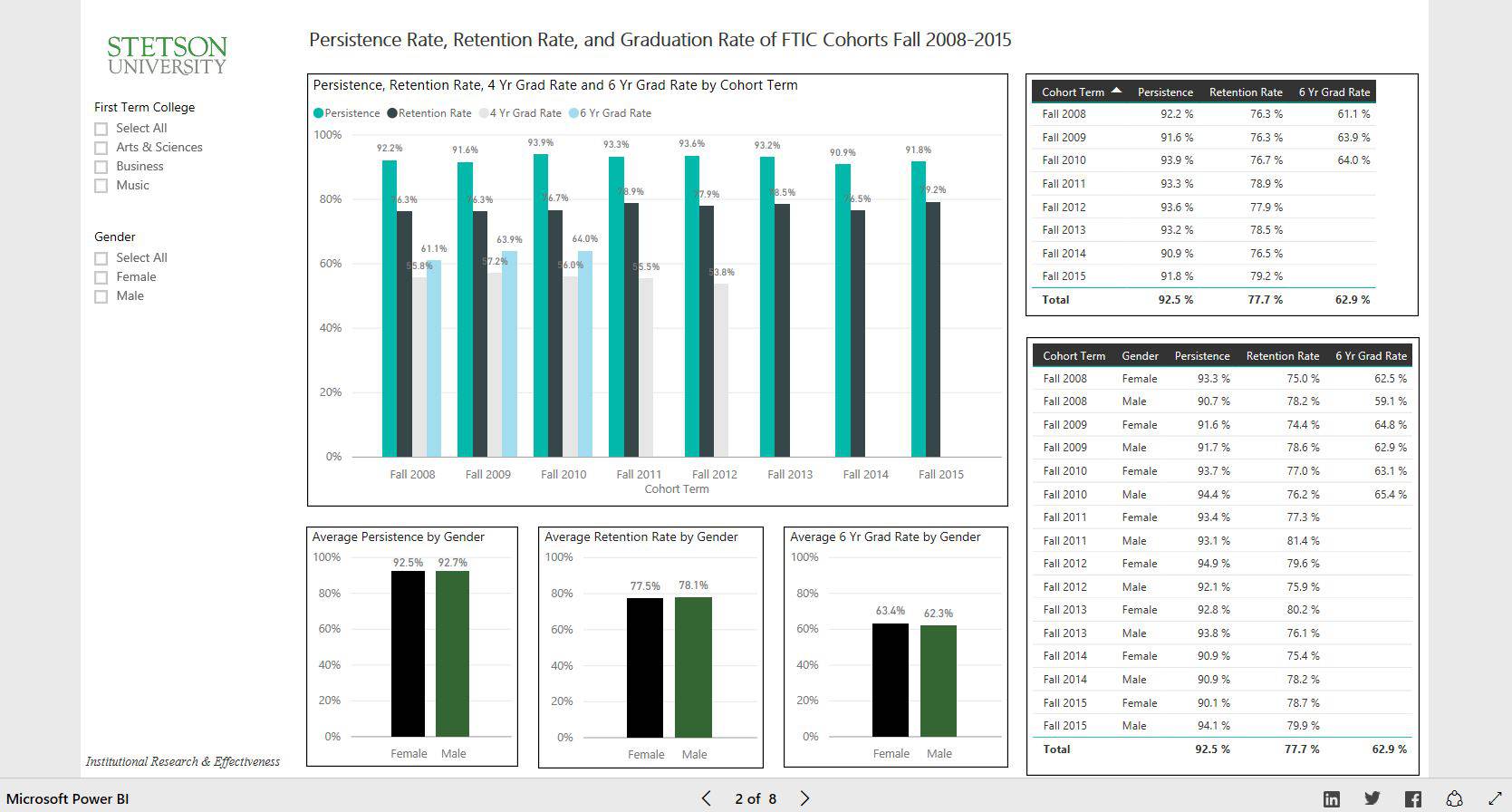
How Stetson University democratizes data-driven decision-making and debunks myths
| Focus on: Empowering Employees, Engaging Students |
Making sense of the massive amounts of data universities gather can be tricky, but it can also be helpful when it comes to definitively answering the most pressing questions facing educators and administrators today. What makes students stay at your university or apply to transfer? What leads to academic successes or struggles, and what are the early warning signs? How can you optimize your curriculum?
This is a real story of digital transformation.
Crunching the Numbers
For Dr. Resche Hines, finding answers to these questions took time—a lot of it. As the Assistant Vice President of Institutional Research and Effectiveness at Stetson University—a university located in DeLand, Florida, a cool 20 miles from Daytona Beach and 30 miles from downtown Orlando—Hines regularly interacts with data and reports from across the entire university. This could range from research to better understand the university’s 4,300 students or crunching the numbers for a new construction project.
Hines recognized the need to find a more scalable, user-friendly solution that could empower his university’s faculty and staff to conduct their own data-driven investigations and engage students and alumni with the most up-to-date information. For Hines, that meant implementing an interactive data visualization tool that helped him draw smarter insights from his institution’s data. That tool was Microsoft Power BI.
Now Stetson’s community is more engaged and more frequently turns to data instead of inherited wisdom and intuition to answer questions. Students and alumni feel more knowledgeable and connected to their campus with readily-digestible, interactive information. Faculty feel supported in their never-ending quest for better curricula and offerings for their students. And perhaps most importantly, Stetson University has enhanced its ability to conduct complex research, have more productive conversations, and debunk long-held institutional myths.
Empowering Employees
“There’s so much data out there that it becomes overwhelming for people to consume. Though you have data on every element you want about your life, there’s no way to easily use it,” explains Hines. “You can get it, but what are you going to do with it? Power BI has allowed us to transition that data to make it usable for the end user, to leverage it, and finally start looking at the data in a comprehensive way.”

Big data is often complex, which makes it difficult for researchers, faculty, staff, and administrators to understand. To encourage user adoption and explain to the Stetson community that Power BI would help alleviate challenges associated with data engagement, Hines and his team went to every school and department chair and personally demonstrated how the tool could be leveraged. Through this personal interaction with his community, Hines was able to directly empower the Stetson faculty and staff.
The easy-to-use platform even transformed critics into advocates. Today, faculty and staff at Stetson are using data to have better structured, more informed conversations about transforming curricula and classroom supplies. “We had a faculty member who was able to use Power BI to ask the Dean of their school for additional resources,” says Hines. “That’s when I knew we were on to something special.”

Power BI has helped Hines debunk many long-held and potentially damaging institutional myths.
“There were some areas of the institution that I thought were pain points for us in terms of retaining students, but we’re actually doing very well in retaining students,” Hines explains. “I thought most of the data would tell us that STEM areas are pain points for any institution in retaining students. Our STEM areas here are out-retaining our general population, which was an amazing discovery. To see that through Power BI was definitely a myth buster for me and for the institution. It helps to change the conversation.”

Engaging Students and Alumni
For prospective, current, and former Stetson students, access to university information has improved dramatically. Federally required information such as enrollment trends, retention, and graduation data is more accessible than ever. Before Power BI, the university could make PDFs for people to download, but the data was static and complex. Students can now interact with and explore data online rather than being forced to download information.
Hines has even seen progress in Stetson’s alumni and stakeholder community. The university is in the early stages of developing a Power BI partnership with Stetson’s Alumni Gifting Program. Hines is currently working on a template to help them understand and leverage historical statistics about the program for the public. For every gifting program, they’ll be able to pull up data on the success of each campaign in progress and understand the intricacies of campaigning. The end goal is to help stakeholders and alumni see data points that have been previously difficult for them to see, such as the best time for email and calling campaigns or which days of the year are the biggest giving days.
Power BI has not only helped debunk myths and change the conversation at Stetson, it has also helped acknowledge students who often go unnoticed.

“Sometimes students outperform their scholarships, which were based on high school performance,” Hines says. “How do we track this and show student appreciation and reward them? Power BI helps us track these students and provide better incentives to show appreciation for their hard work.”
Microsoft is proud to partner with Resche Hines and Stetson University as they continue to engage students and empower faculty and administrators to achieve more.

| View enrollment report | View retention report | Build your own dashboard |
The downloadable zip file contains the following items to help you quickly create your own sample retention report in Power BI:
- A step by step guide to setting up the files and configuring Power BI
- A Data Dictionary, which contains detailed information on the FTIC (first time in college) views, tables, and variables used to create the extracted data file
- A sample Excel source data workbook
- The Higher Education Retention report template which contains the data model and reports
The documentation included in the download assumes users understand how to extract data from their existing source systems and does not provide detailed guidance on this aspect of the process.
If you have any questions, suggestions, or concerns, please feel free to email Patrick LeBlanc at [email protected], Dr. Resche Hines, Ph.D. ([email protected]), or Angela Henderson ([email protected]).
Related Content
Learn how to get started with the cloud in education with this free on-demand webcast.
See how Stetson University learned to draw smarter insights from their student data.





